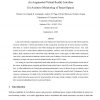45 search results - page 8 / 9 » Responses of Participants During an Immersive Virtual Enviro... |
CGA
2008
13 years 7 months ago
2008
This paper studies the use of visual blur effects, i.e., blurring of parts of the image fed back to the user, for First-Person-Navigations in Virtual Environments (VE). First, we ...
PERCOM
2004
ACM
14 years 7 months ago
2004
ACM
Large sensor networks in applications such as surveillance and virtual classrooms, have to deal with the explosion of sensor information. Coherent presentation of data coming from...
TVCG
2012
11 years 10 months ago
2012
—Motion perception in immersive virtual environments significantly differs from the real world. For example, previous work has shown that users tend to underestimate travel dista...
AI
2004
Springer
13 years 7 months ago
2004
Springer
Over the last years evidence has accumulated that shows the possibility to analyze human brain activity on-line and translate brain states into actions such as selecting a letter ...
PRESENCE
2002
13 years 7 months ago
2002
The literature often suggests that proprioceptive and especially vestibular cues are required for navigation and spatial orientation tasks involving rotations of the observer. To ...

